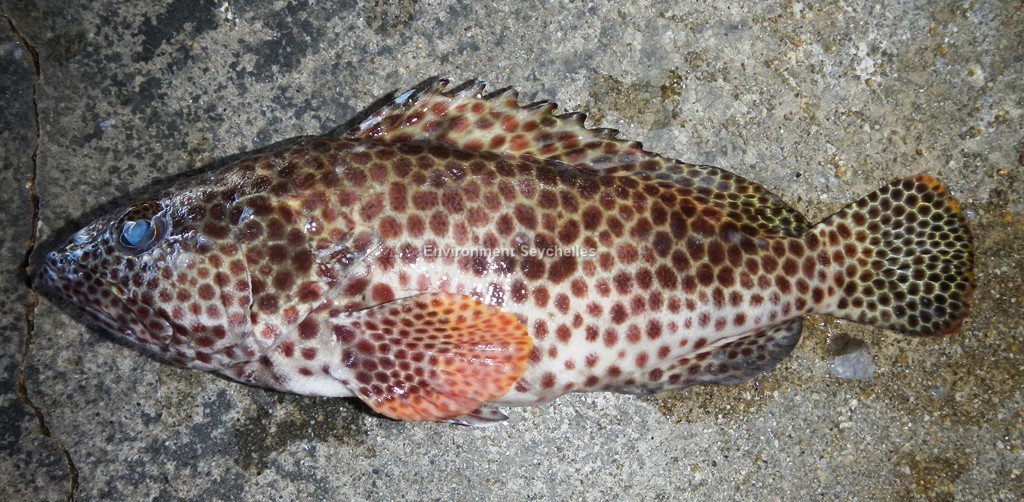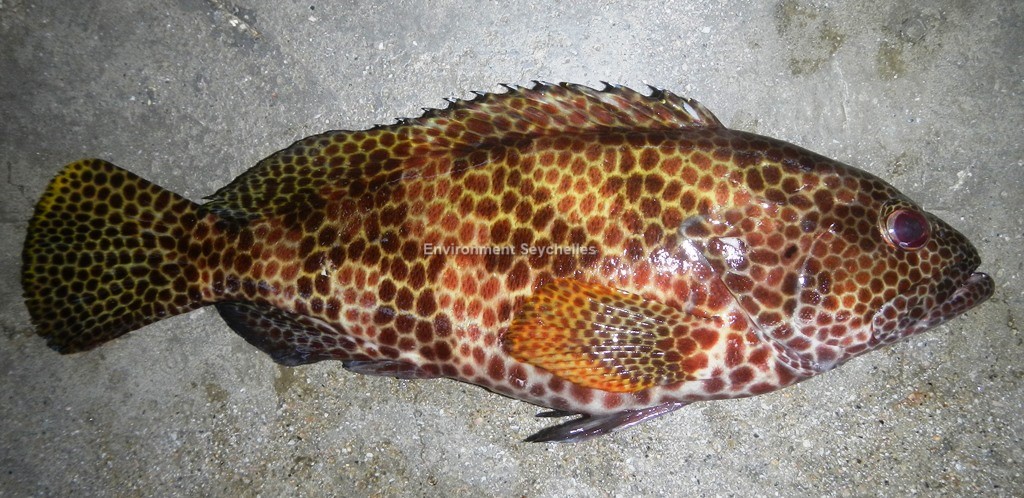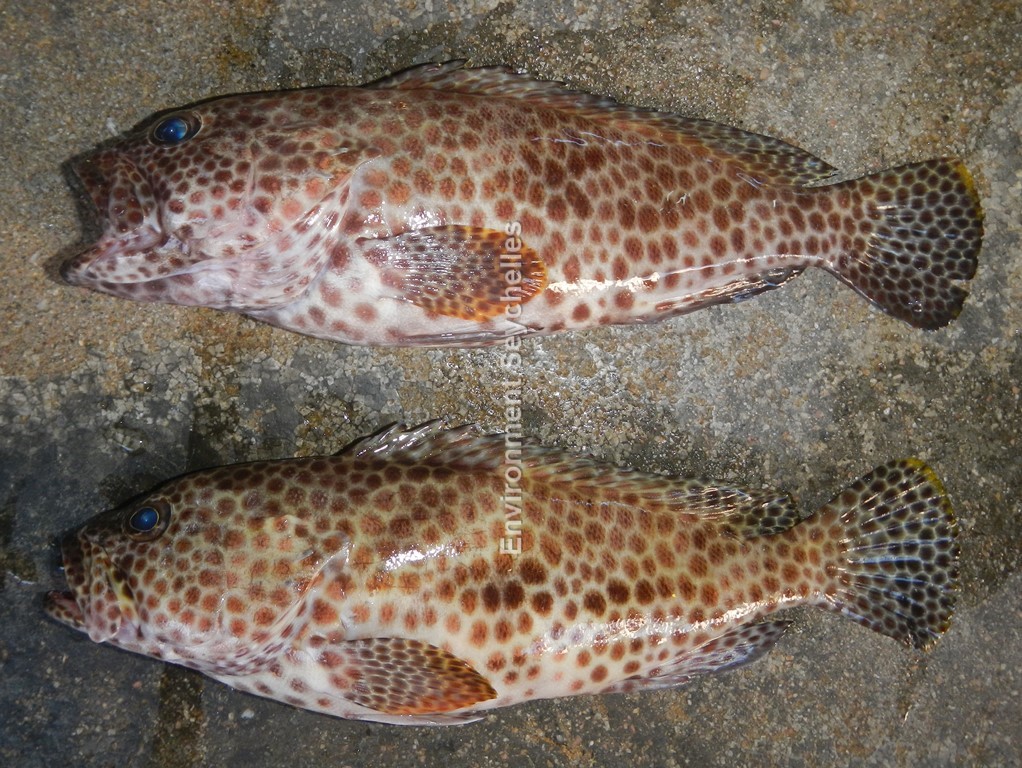Description:
Dorsal spines: 11; Dorsal rays: 15-17; Anal spines: 3; Anal rays: 8.
A small, moderately full-bodied, grouper. Dorsal head profile convex. Flat interorbital area. Posterior and anterior nostrils are subequal or posterior nostrils larger.
Maxilla reaches past vertical at rear edge of eye. Midlateral part of lower jaw with 2 to 4 rows of teeth, the inner teeth about twice the length of outer teeth. Rounded or
subangular preopercle, serrae at angle enlarged. Operculum with upper edge almost straight. Rounded caudal fin.
Colour. Head, body and fins pale, covered with close set dark brown or reddish brown polygonal spots the interspaces forming an irregular pale reticulum giving the species
its “honeycomb” common name. Spots on the ventral part of the body pale, more widely spaced and diffuse in outline. A series of about five darker diagonal bands, two to five
polygons wide, occur on the body, the anterior most radiating from the eye. Dark spots on median fins become smaller towards the fin margin. Tips of interspinous dorsal fin
membranes white or pale yellow with small sub-marginal dark patch. Pectoral fins covered with distinct brown spots.
Size:
Maturity: Lm unknown. Range 19- ? cm. Max Length: 32 cm TL.
Habitat and Ecology:
Inhabits coastal and offshore coral reefs (depth 0-50 m but typically less than 20 m). Favours shallow lagoons and semi-protected seaward reefs. Juveniles are common in
thickets of staghorn corals of the genus acropora. Feeds on fishes and small invertebrates. A protogynous hermaphrodite with changing from female to male at 3 to 5 years.
Solitary. Forms spawning aggregations outside home reef.
Fishery Status:
This species is not protected or subject to fishery regulations. It is caught occasionally in the fish trap fishery, but more commonly it is caught in nets that are illegally
dragged over the reefs/reef flats.
Notes:
It shares its creole name with E. spilotoceps. The name reflects that fishers state where this fish is found an octopus ("zourit") will be found nearby.
References:
Bray, D.J. Epinephelus merra in Fishes of Australia, http://fishesofaustralia.net.au/home/species/3848 (05/03/19).
Craig, M.T. et al. (2011). Groupers of the World - a field and market guide. NISC (Pty) Ltd, South Africa. ISBN: 978-1-920033-11-8
Froese, R. & D. Pauly. (Eds.) (2019). FishBase. https://www.fishbase.se/summary/4923 (05/03/19).
Law, C. et al. (2018). Epinephelus merra. The IUCN Red List 2018: http://dx.doi.org/10.2305/IUCN.UK.2018-2.RLTS.T132788A100551598.en. (05/03/19)
Citation:
Nevill, J.E.G. (2019). Epinephelus merra, Honeycomb grouper. Seychelles Seatizens. www.seatizens.sc. https://seatizens.sc/species/epinephelus-merra-bloch-1793/ (revised 20/07/22).




pin-up kazino: pin up azerbaijan – pin up yukle
mexican mail order pharmacies: northern doctors – buying prescription drugs in mexico
buying from online mexican pharmacy mexican northern doctors mexico drug stores pharmacies
mexican mail order pharmacies: northern doctors pharmacy – best online pharmacies in mexico
buying from online mexican pharmacy: Mexico pharmacy that ship to usa – buying from online mexican pharmacy
mexico drug stores pharmacies: northern doctors – mexico pharmacies prescription drugs
http://northern-doctors.org/# mexican mail order pharmacies
mexican drugstore online mexican pharmacy northern doctors mexican drugstore online
http://northern-doctors.org/# mexican drugstore online
mexican online pharmacies prescription drugs: mexican northern doctors – medication from mexico pharmacy
https://northern-doctors.org/# purple pharmacy mexico price list
medication from mexico pharmacy: Mexico pharmacy that ship to usa – mexican pharmacy
mexican border pharmacies shipping to usa: northern doctors – medicine in mexico pharmacies
mexican border pharmacies shipping to usa Mexico pharmacy that ship to usa medicine in mexico pharmacies
https://northern-doctors.org/# pharmacies in mexico that ship to usa
reputable mexican pharmacies online pharmacies in mexico that ship to usa mexico pharmacies prescription drugs
mexico drug stores pharmacies: mexican northern doctors – п»їbest mexican online pharmacies
pharmacies in mexico that ship to usa: mexican pharmacy northern doctors – п»їbest mexican online pharmacies
pharmacies in mexico that ship to usa: northern doctors – reputable mexican pharmacies online
best online pharmacies in mexico: Mexico pharmacy that ship to usa – buying from online mexican pharmacy
https://northern-doctors.org/# medicine in mexico pharmacies
mexican drugstore online: mexican pharmacy – mexican border pharmacies shipping to usa
mexican pharmacy: northern doctors pharmacy – mexico drug stores pharmacies
buying prescription drugs in mexico online: northern doctors – buying prescription drugs in mexico online
pharmacies in mexico that ship to usa: mexican pharmacy online – medicine in mexico pharmacies
http://northern-doctors.org/# mexican online pharmacies prescription drugs
mexico pharmacies prescription drugs northern doctors pharmacy mexican border pharmacies shipping to usa
mexican rx online: mexican pharmacy – mexican drugstore online
mexican mail order pharmacies northern doctors pharmacies in mexico that ship to usa
mexico drug stores pharmacies: mexican pharmacy online – best online pharmacies in mexico
mexican rx online: mexican pharmacy online – mexico drug stores pharmacies
mexican online pharmacies prescription drugs mexican rx online purple pharmacy mexico price list
mexican pharmaceuticals online: medication from mexico pharmacy – mexican pharmaceuticals online
reputable mexican pharmacies online northern doctors pharmacy mexico drug stores pharmacies
http://northern-doctors.org/# mexican drugstore online
http://northern-doctors.org/# mexican border pharmacies shipping to usa
mexican pharmaceuticals online: mexican pharmacy – medicine in mexico pharmacies
https://northern-doctors.org/# mexico drug stores pharmacies
reputable mexican pharmacies online: mexican border pharmacies shipping to usa – mexico drug stores pharmacies
medicine in mexico pharmacies: Mexico pharmacy that ship to usa – medication from mexico pharmacy
https://northern-doctors.org/# mexico pharmacy
mexico drug stores pharmacies: northern doctors – mexican pharmaceuticals online
https://northern-doctors.org/# mexico drug stores pharmacies
medicine in mexico pharmacies mexican pharmacy mexican mail order pharmacies
mexican rx online: Mexico pharmacy that ship to usa – best online pharmacies in mexico
mexican pharmacy: northern doctors pharmacy – medicine in mexico pharmacies
best online pharmacies in mexico mexican pharmacy online mexican pharmaceuticals online
mexican mail order pharmacies: mexican pharmacy northern doctors – mexican border pharmacies shipping to usa
http://northern-doctors.org/# mexican mail order pharmacies
buying prescription drugs in mexico online: northern doctors pharmacy – mexico pharmacy
mexican mail order pharmacies: Mexico pharmacy that ship to usa – medicine in mexico pharmacies
mexican drugstore online: mexican pharmacy online – reputable mexican pharmacies online
reputable mexican pharmacies online: mexican pharmacy online – п»їbest mexican online pharmacies
https://northern-doctors.org/# reputable mexican pharmacies online
buying from online mexican pharmacy: mexican pharmacy northern doctors – buying prescription drugs in mexico
buying from online mexican pharmacy: northern doctors – п»їbest mexican online pharmacies
reputable mexican pharmacies online northern doctors medicine in mexico pharmacies
purple pharmacy mexico price list mexican pharmacy northern doctors mexico pharmacies prescription drugs
mexico pharmacies prescription drugs: Mexico pharmacy that ship to usa – buying prescription drugs in mexico online
mexico drug stores pharmacies: northern doctors pharmacy – mexico drug stores pharmacies
buying from online mexican pharmacy: Mexico pharmacy that ship to usa – mexican online pharmacies prescription drugs
Excellent content! The way you explained the topic is impressive. For a deeper dive, check out this resource: EXPLORE FURTHER. What do you all think?
mexican online pharmacies prescription drugs: mexican pharmacy – buying prescription drugs in mexico online
https://northern-doctors.org/# mexican border pharmacies shipping to usa
mexican pharmacy: mexico drug stores pharmacies – mexico drug stores pharmacies
medication from mexico pharmacy: mexican pharmacy online – best online pharmacies in mexico
mexican rx online: mexican northern doctors – reputable mexican pharmacies online
mexico pharmacies prescription drugs Mexico pharmacy that ship to usa mexican online pharmacies prescription drugs
mexican pharmaceuticals online: mexican pharmacy – mexico pharmacy
mexico drug stores pharmacies: northern doctors pharmacy – medication from mexico pharmacy
buying from online mexican pharmacy mexican northern doctors best online pharmacies in mexico
purple pharmacy mexico price list: northern doctors – mexico drug stores pharmacies
п»їbest mexican online pharmacies: buying prescription drugs in mexico – mexican online pharmacies prescription drugs
mexican mail order pharmacies: mexican pharmacy – medication from mexico pharmacy
buying prescription drugs in mexico online online mexican pharmacy mexican border pharmacies shipping to usa
https://cmqpharma.online/# buying prescription drugs in mexico
buying prescription drugs in mexico
https://cmqpharma.com/# mexico drug stores pharmacies
mexican pharmaceuticals online
Online medicine home delivery: top online pharmacy india – mail order pharmacy india
https://foruspharma.com/# medication from mexico pharmacy
canadian pharmacy ltd canadian pharmacy in canada canadian pharmacy world reviews
https://canadapharmast.online/# canada drug pharmacy
mexico pharmacy mexican drugstore online purple pharmacy mexico price list
reputable mexican pharmacies online: medication from mexico pharmacy – purple pharmacy mexico price list
top 10 pharmacies in india: india pharmacy mail order – buy prescription drugs from india
medicine in mexico pharmacies: medicine in mexico pharmacies – mexican mail order pharmacies
mexican border pharmacies shipping to usa mexican rx online reputable mexican pharmacies online
https://foruspharma.com/# medicine in mexico pharmacies
medication from mexico pharmacy: buying from online mexican pharmacy – buying from online mexican pharmacy
http://foruspharma.com/# medicine in mexico pharmacies
mexican online pharmacies prescription drugs: mexican mail order pharmacies – medication from mexico pharmacy
purple pharmacy mexico price list: mexico drug stores pharmacies – mexican online pharmacies prescription drugs
mexican mail order pharmacies: mexico drug stores pharmacies – mexican mail order pharmacies
buying prescription drugs in mexico pharmacies in mexico that ship to usa mexican pharmaceuticals online
online canadian drugstore: canadapharmacyonline legit – canadian drug pharmacy
india pharmacy mail order reputable indian pharmacies п»їlegitimate online pharmacies india
https://indiapharmast.com/# pharmacy website india
mexican mail order pharmacies: mexico drug stores pharmacies – pharmacies in mexico that ship to usa
mail order pharmacy india: india online pharmacy – reputable indian online pharmacy
https://foruspharma.com/# buying from online mexican pharmacy
online shopping pharmacy india: top online pharmacy india – Online medicine home delivery
https://clomiddelivery.pro/# how to buy cheap clomid
Paxlovid over the counter: paxlovid buy – paxlovid generic
paxlovid generic: paxlovid for sale – п»їpaxlovid
https://clomiddelivery.pro/# can i order generic clomid without rx
https://paxloviddelivery.pro/# paxlovid cost without insurance
doxycycline purchase: average cost for doxycycline – buy doxycycline tablets 100mg
http://doxycyclinedelivery.pro/# doxycycline medication cost
amoxicillin tablet 500mg: amoxicillin tablets in india – generic amoxil 500 mg
https://paxloviddelivery.pro/# paxlovid covid
https://paxloviddelivery.pro/# buy paxlovid online
doxycycline prescription coupon: 20 doxycycline – doxycycline capsules 40 mg
amoxicillin where to get: amoxil pharmacy – amoxicillin 500mg over the counter
https://ciprodelivery.pro/# buy ciprofloxacin
http://doxycyclinedelivery.pro/# oral doxycycline
ciprofloxacin 500 mg tablet price: buy cipro without rx – buy cipro online canada
http://ciprodelivery.pro/# cipro
http://doxycyclinedelivery.pro/# doxycycline vibramycin
doxycycline no prescription best prices: doxycycline 100mg for sale – doxycycline cheap uk
http://clomiddelivery.pro/# cheap clomid without a prescription
https://ciprodelivery.pro/# ciprofloxacin mail online
buy cipro cheap: ciprofloxacin 500mg buy online – cipro online no prescription in the usa
http://ciprodelivery.pro/# ciprofloxacin 500 mg tablet price
paxlovid generic: paxlovid covid – paxlovid buy
https://amoxildelivery.pro/# purchase amoxicillin 500 mg
http://paxloviddelivery.pro/# Paxlovid buy online
buy cipro online usa: buy cipro no rx – cipro 500mg best prices
amoxicillin without a doctors prescription: amoxicillin 500mg capsules antibiotic – order amoxicillin online uk
where to get generic clomid without dr prescription: where to buy clomid no prescription – can you get generic clomid online